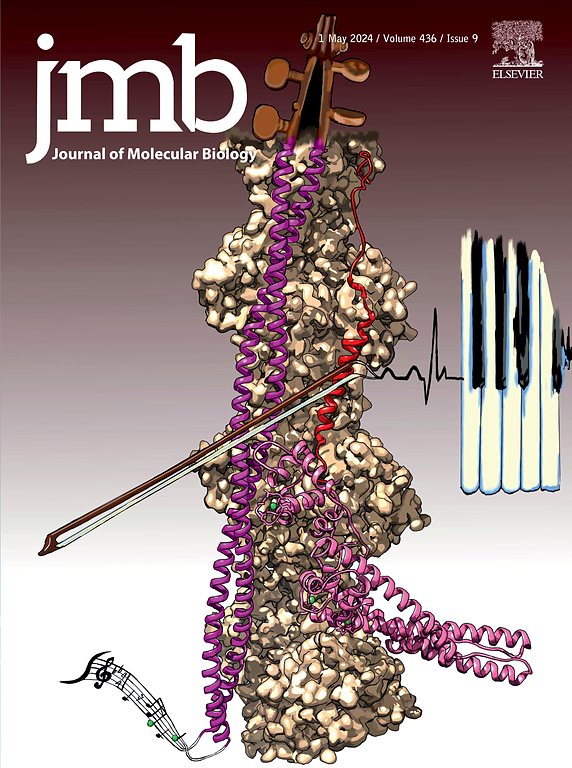恶性疟原虫Plasmodium plasmepsin X的结构可塑性以适应强效大环羟乙胺抑制剂的结合。
IF 4.7
2区 生物学
Q1 BIOCHEMISTRY & MOLECULAR BIOLOGY
引用次数: 0
摘要
恶性疟原虫plasciparum plasmepsin X (PMX)由于其在寄生虫生命周期中的重要作用,已成为开发新型抗疟药物的首选靶点。在这里,我们描述了1.7Å晶体结构的PMX非共价结合的强效大环拟肽抑制剂(7k)具有羟乙胺(HEA)支架。在7k结合后,该酶采用了一种新的构象,主要涉及s2s2环(M526-H536)和S2瓣(F311-G314)。这导致PMX的活性位点部分关闭,并在PMX的撇(S')和非撇(S)位点广泛相互作用。天冬氨酸催化残基D266和D467直接与HEA药效团相互作用。7k衍生物化合物7a的对接,突出了S3口袋中靠近S3柔性环(H242-F248)的区域,该区域可能是配体稳定的关键。PMX的动态特性及其在抑制剂结合时经历不同类型诱导契合的倾向,使得能够产生针对这种必需的疟疾天冬氨酸蛋白酶的强效抑制剂。本文章由计算机程序翻译,如有差异,请以英文原文为准。

Structural Plasticity of Plasmodium falciparum Plasmepsin X to Accommodate Binding of Potent Macrocyclic Hydroxyethylamine Inhibitors
Plasmodium falciparum plasmepsin X (PMX) has become a target of choice for the development of new antimalarial drugs due to its essential role across the parasite life cycle. Here we describe the 1.7 Å crystallographic structure of PMX noncovalently bound to a potent macrocyclic peptidomimetic inhibitor (7k) possessing a hydroxyethylamine (HEA) scaffold. Upon 7k binding, the enzyme adopts a novel conformation, with significant involvement of the S2′S2 loop (M526-H536) and the S2 flap (F311-G314). This results in partial closure of the active site with widespread interactions in both the prime (S′) and the non-prime (S) sites of PMX. The catalytic aspartate residues D266 and D467 directly interact with the HEA pharmacophore. Docking of a 7k derivative, compound 7a, highlights a region in the S3 pocket near the S3 flexible loop (H242-F248) that may be key for ligand stabilisation. The dynamic nature of PMX and its propensity to undergo distinct types of induced fit upon inhibitor binding enables generation of potent inhibitors that target this essential malarial aspartic protease.
求助全文
通过发布文献求助,成功后即可免费获取论文全文。
去求助
来源期刊

Journal of Molecular Biology
生物-生化与分子生物学
CiteScore
11.30
自引率
1.80%
发文量
412
审稿时长
28 days
期刊介绍:
Journal of Molecular Biology (JMB) provides high quality, comprehensive and broad coverage in all areas of molecular biology. The journal publishes original scientific research papers that provide mechanistic and functional insights and report a significant advance to the field. The journal encourages the submission of multidisciplinary studies that use complementary experimental and computational approaches to address challenging biological questions.
Research areas include but are not limited to: Biomolecular interactions, signaling networks, systems biology; Cell cycle, cell growth, cell differentiation; Cell death, autophagy; Cell signaling and regulation; Chemical biology; Computational biology, in combination with experimental studies; DNA replication, repair, and recombination; Development, regenerative biology, mechanistic and functional studies of stem cells; Epigenetics, chromatin structure and function; Gene expression; Membrane processes, cell surface proteins and cell-cell interactions; Methodological advances, both experimental and theoretical, including databases; Microbiology, virology, and interactions with the host or environment; Microbiota mechanistic and functional studies; Nuclear organization; Post-translational modifications, proteomics; Processing and function of biologically important macromolecules and complexes; Molecular basis of disease; RNA processing, structure and functions of non-coding RNAs, transcription; Sorting, spatiotemporal organization, trafficking; Structural biology; Synthetic biology; Translation, protein folding, chaperones, protein degradation and quality control.
 求助内容:
求助内容: 应助结果提醒方式:
应助结果提醒方式:


